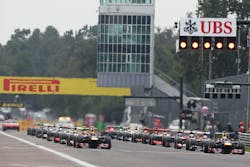Monza is Pirelli’s home race, located just half an hour’s drive from the company’s global headquarters in Milan, where this year’s Formula One tires are designed.
It has significant lateral energy demands, thanks to its famous fast corners such as Parabolica, and also big longitudinal demands in terms of traction and braking, because of the long straights followed by slow chicanes.
For this reason, Pirelli is bringing the two hardest tires in the range: P Zero Orange hard and P Zero White medium. As well as the forces going through the tires, the actual tire structure itself faces heavy punishment due to the high kerbs that are a well-known feature of the Italian circuit. The drivers use these extensively to find the fastest racing line, and the tire plays a key role in absorbing the impacts as part of the suspension.
This year, levels of aerodynamic downforce have been reduced by the regulations, which means that while cornering speeds are slower, the cars will reach some of the highest top speeds seen all year, in the region of 360kph.
Paul Hembery, Pirelli motorsport director: “Racing at home is always a source of immense pleasure and pride for us, particularly because many of our employees who don’t normally travel to races get to see our tires in action for the only time all season. Our home race also happens to be one of the most demanding races of the year for the tires, due to the rapid layout of the circuit: the reason why Monza is known as ‘the temple of speed’. The faster a circuit is, generally the more stressful it is for the tires because of the heat build-up that all these forces entail. The cars run a very low downforce set-up for Monza to maximize their top speed on the straights. This has a distinct effect on the tires, as less downforce means that the cars tend to slide more and run a greater risk of wheels locking up in the braking areas, which are a key element of Monza. These lock-ups can lead to flat spots, although the design of our tire structure and compounds this year means that flat spots are a much less common occurrence than they used to be.”
The circuit from a tire point of view:
Like Spa, plenty of energy goes through the tires at Monza. On the straights top speeds can exceed 360kph. Together with braking areas where drivers shed 250kph in a short space of time, this generates longitudinal force of 4.5g. These conditions combined raise the temperature of the compounds up to peaks of 130 degrees, on the surface of the tread.
The medium tire is a low working range compound, capable of achieving optimal performance even at a wide range of low temperatures. The hard tire by contrast is a high working range compound, suitable for higher temperatures. Ambient temperatures are usually warm at Monza, but it has also rained in the past – including just before the start of the race last year.
Drivers use the lowest downforce set-up of the year, in order to extract maximum speed on the fast straights: the key to a quick lap time. This means that the tires have to provide all the mechanical grip necessary to get the cars through the corners.
The winning strategy last year was a one-stopper, with Red Bull’s Sebastian Vettel starting on the medium tire and then switching to the hard on lap 23. Ferrari driver Fernando Alonso used the same strategy to finish second from fifth on the grid.



